The Jain Temples of Nagarparkar
 Zulfiqar Ali Kalhoro
Zulfiqar Ali Kalhoro
Updated: 13.04.2015
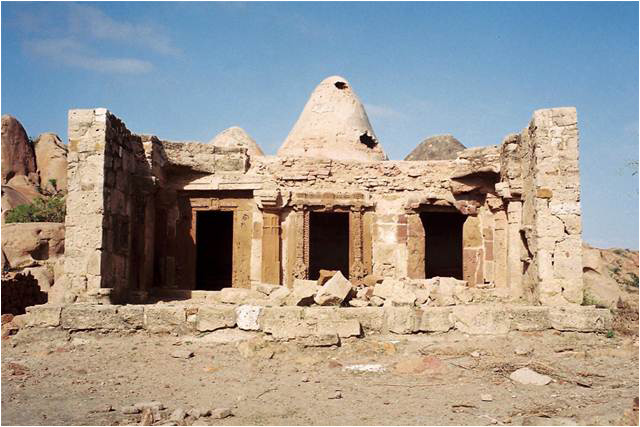
Jain temple at Bodhesar
Nagarparkar in Sindh has great historical significance, boasting such sites as the Bodhesar mosque, the Sati and hero stones, the fortresses of the Rajputs. Equally spectacular, though less well-known, are its Hindu and Jain temples.
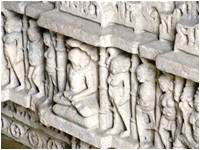 | 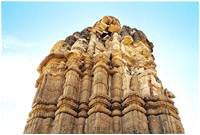 |
Lord Parsvanatha being flanked by Yaksha Dharanendra and Yakshi Padmavati | Another temple at Bodhesar |
Situated on the south-eastern border of Sindh, Karoonjhar is a 16-mile range of big and small hills that surround the Nagarparkar town. This mountain range of the Thar desert contains old Jain and Hindu temples, the ancient city of Pari Nagar, memorial stones, granite deposits and rare flora and fauna. The songs of peacocks echoing in vales and ancient sites like Bodhesar talao (water tank) add to its scenic as well as historical importance. Its highest peak is 1,000 feet above sea level and is known as Tarwat's peak. In ancient times Karoonjhar was also known as Kinro. Today it is a mountain of myth and reality. There are many scared spaces associated with Shaivites and Jain munis, the followers of Lord Mahavira and Parsanatha. Yogis and Jain munis used to practice austerities in the hills of Karoonjhar. There are still some temples here, of which some lie in dilapidated condition and others are temded by the local Hindu community of Nagarparkar town.
 | 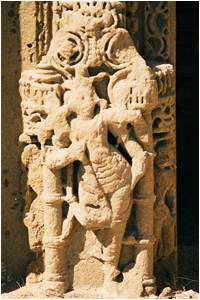 |
Architrave of a temple decorated with images | |
At Bodhesar, 5km north-west of Nagarparkar town, and by the side of the talao (pond) at the foothill of the Karoonjhar, lies a beautiful, shining white mosque. This mosque, though small in size, is said to have been built by Sultan Mehmood Begra, the ruler of Gujarat. An inscription on the mosque reads the name of Mehmood Shah Bin Muzaffar Shah Bin Ghiyasuddin, and lists the year H-880/1505.
Prior to describing the temples scattered throughout Nagarparkar taluka or subdivision, some light should be thrown on the practices of the Jain religion. Along with Buddhism, Jainism was the most important reform movement that established an independent unit from Hinduism. The word is derived from Jina, meaning victor or conqueror, implying final victory over bondage to life's misery. Jainism has a universal message of nonviolence or ahimsa.
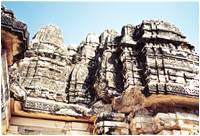 | 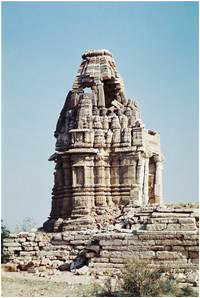 |
Jain temple of Parsvanatha at Gori village | |
Jainism denies the creator-god. However, human teachers called Tirthankaras (ford-makers) are worshipped once they reach liberation. Jainism was founded by Rishabanatha and attained a major status in India at the time of Mahavira, who was born in about 599 BC in northern India in a royal family. When he was about 30 years old, after he had been a householder, Mahavira decided to abandon his aristocratic surroundings in favour of an ascetic life. He set aside his fine raiment, gave away his treasures, and embarked upon a severe regimen. For twelve years, he underwent castigation, enduring bodily and spiritual injury and emerged a teacher of many monks, a renowned preacher and the propounder of a new religion.
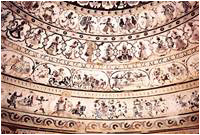 | 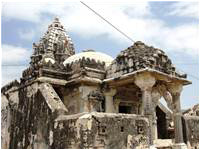 |
Painting inside the Gori temple | Jain temple in Nagarparkar Bazaar |
Chief among the tenets of Jainism is the deification of Mahavira. The Agamas (precepts) and Siddhantas (treatises) declare him to be a preeminent and venerable savior of men, and the last of 24 Tirthankaras. Jainism also preaches that karma is knowable, ineffable and a cosmic power which directs retribution in the hereafter.
In line with the founder's austerity, a Jain is admonished to follow an ethical programme of exacting discipline. The distinctive principle of Jainism is 'ahimsa' or nonviolence towards all living creatures in both thought and action. Jainism distinguishes between Digambara (sky-clad or unclothed) and Svetambara (white clad) sects. The line of difference is drawn between Digambara going naked and Svetambara in white, otherwise both agree on cosmology, ethics and philosophy.
 | 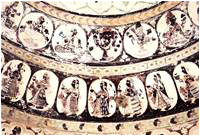 |
Jain temples were noted for their marble images |
The spread and prosperity of Jainism in Sindh is marked by the presence of temples in Thar and Parkar. In particular: Gori, Viravah, Bodhesar, Sati Dhara, Umarkot town, Gadro and Nagaparkar are known locally for their Jain temples. A temple located in Nagarparkar bazaar is remarkable for its grace and elegance. It is richly decorated with sculptures and paintings. The carving on the pillars and on the entrance of the temple is magnificent.
Apart from this fabulously carved temple, there exist a cluster of three temples at Bodhesar - supposed to have been built in 1375 AD and 1449 AD. Two temples with corbelled domes are built of kanjur and redstone, and are finely carved. The third temple, which is raised on a platform, is most inspiring and imposing - though now it's in a pathetic condition. The upper part of the shikhara of this temple has fallen. This temple is believed to have been built by a Jain woman and is locally called Poni Daharo.
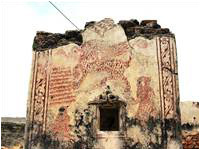 | 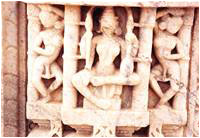 |
Religious building near the Jain temple in Nagarparkar Bazaar | Jain images from Bhodesar |
24 km north of Nagarparkar at Viravah stands a Jain temple in a neglected and desolate state. It is built in white marble and consists of an open group of pillars with carved capitals. Captain S.N. Raikes while traveling through this area in 1856 found the remains of five or six Jain temples mostly made of white marble. At present, only one temple survives. Near the western side of the temples are lying several valuable pieces of Jain sculptures which were accidentally found during the road construction. Some were left at the temple while the others were placed in the museum of Umarkot.
 | 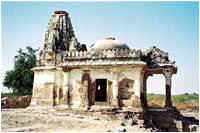 |
Jain temple of Rekho Dev at Vira Vah | |
There is another Jain temple at Gorri, some 20 km north-west of Viravah which also lies in a deplorable condition. It is believed to have been built during the heydays of the Sodhas around 1376 A.D. It has exquisitely decorated interiors reflecting the highly developed aesthetic sensibility of those who made it. The canopy which also serves as an entrance to the temple is decorated with paintings representing the Jaina mythologies. However, the paintings of Parsvanatha being welcomed by yakshas and yakshinis are found in the domed ceiling of the canopy. As one enters the main hall of the temple, one finds on either side of the hall 12 cells thus making the total number 24.
 It may be used for housing images of 24 tirthankaras. It is very similar to the one at Bodhesar but far more superior in craftsmanship and finish, bearing architectural influence from adjacent Rajasthan from where the followers of the faith infiltrated into Nagarparkar and brought a new style of temple architecture.
It may be used for housing images of 24 tirthankaras. It is very similar to the one at Bodhesar but far more superior in craftsmanship and finish, bearing architectural influence from adjacent Rajasthan from where the followers of the faith infiltrated into Nagarparkar and brought a new style of temple architecture. The writer is a research anthropologist at Pakistan Institute of Development Economics (PIDE), Islamabad. He may be contacted at [email protected]
